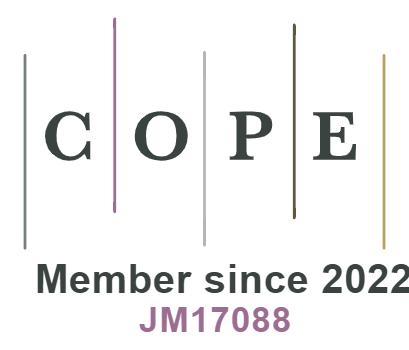Extended state observer-based fault-tolerant control for an unmanned surface vehicle under asynchronous injection and deception attacks
Abstract
This paper explores the problem of fault-tolerant control concerning an underactuated unmanned surface vehicle affected by actuator faults and disturbances in the physical layer and multiple cyber threats (time-varying delays, injection attacks, and deception attacks) in the networked layer. Firstly, an extended state observer is designed to estimate the relative state and fault information by constructing the estimation error term based on the output information affected by injection attack and delay. Secondly, a novel fault-tolerant controller is designed to deal with random Bernoulli deception attacks and compensate for time-varying delay and actuator faults by using the estimated information and considering the probability dynamics of deception attacks. Assuming that dual-channel asynchronous independent injection and deception attacks occur on the sensor-to-observer and observer-to-controller channels. A sufficient condition for asymptotic stability of the unmanned surface vehicle is derived by using Lyapunov-Krasovskii functional within the co-design framework of fault estimation and fault-tolerant control, and ensured by eliminating the equality constraint. Finally, the efficacy of the proposed algorithm is assessed through simulations of the unmanned surface vehicle under two distinct scenarios: low forward speed and high forward speed.
Keywords
1. INTRODUCTION
For the past few years, the relevant technology of unmanned surface vehicles (USVs) has undergone rapid advancements, garnering substantial attention across various fields including military operations[1], ocean exploration[2], and maritime monitoring [3]. An overview of control methods for USVs can be seen [4]. Notably, considerable attention has been devoted to the fault-tolerant control (FTC) of nonlinear steering controlled[5], underactuated[6], and fully actuated [7] USVs. An active FTC method for the USV is discussed [8], while[9] provides insights into a passive FTC approach. More cutting-edge research on FTC can be seen [10–12]. Consequently, further exploration of FTC strategies for USVs is imperative to bolster reliability and stability of the system.
Given the intricacies of the marine environment, numerous accidents, including sensor faults (dead fault, biased fault, and random drift) and actuator faults (stuck steering mechanism-type fault and noise-type fault) along with insufficient thrust due to external disturbances, are prone to occur during mission execution. The smooth movement of USVs hinges upon various factors such as environmental perception and attitude control. These physical threats not only degrade the overall performance of USVs but also pose the risk of severe accidents. Hence, the FTC issues of USVs under physical threats are now receiving considerable attention [13–15]. An observer is constructed based on an intermediate variable and an FTC protocol is designed for a USV with actuator faults and partial transmission data loss [15]. Specifically, the FTC of USVs under actuator faults [16], sensor faults [17], thruster faults [18], actuator faults and disturbances [19] is investigated. In the FTC research, the observer-based active FTC method stands as a prominent choice [8, 20, 21]. This approach revolves around extracting fault information from the fault estimation (FE) and subsequently designing an FTC strategy based on the estimated information. However, prevailing observer-based FTC methods conventionally separate the front-end FE from the back-end FTC which complicates the research of USVs. Conversely, the co-design of FE and FTC not only mitigates complexity but also abbreviates fault response durations, rendering it more conducive for a USV to move in complex environments. Therefore, it is necessary to further explore the applicability of FE and FTC co-design framework within the realm of USVs.
In addition to the adverse effects stemming from the aforementioned physical threats, the advancement of USV intelligence is also accompanied by cyber risks. On the one hand, attacks in the networked layer damage the connectivity of transmission channels and the integrity of data, diminishing the reliability of the USV and potentially leading to the deviation from prescribed routes and loss of control. Therefore, when facing such malicious attacks as denial of service (DoS) attack, deception attack, injection attack, how to design a suitable FTC scheme to withstand the impact is crucial. A concise summary of cyber threats faced by USVs across different domains is provided, and a data protection scheme is presented [22]. Under the framework of co-design, a distributed control method based on the distributed unknown input observer is adopted to solve the distributed security control problem of multiple USVs under aperiodic DoS attacks [23]. An event-triggered communication scheme and an event-based switching control system are proposed to deal with both delayed and aperiodic DoS attacks [24]. A new defense and tolerance technology is adopted to deal with malicious connection hybrid attacks in the networked layer and solve the distributed tracking control problem of multiple USVs [25]. However, the predominant focus of current research lies in the FTC for USVs under periodic/aperiodic DoS attacks [23, 24, 26]. Different from DoS attacks which lead to serious communication interruption, deception attacks and injection attacks compromise the integrity and confidentiality of transmitted data by manipulating them, which causes misoperation of USVs and brings substantial security risks. On the other hand, the presence of network-induced delay significantly influences the real-time efficacy of USV control instructions, which greatly limits the flexibility of the system when performing tasks requiring rapid response such as obstacle avoidance. An event-triggered control design method for multiple USVs constrained by communication delay and drive resources is proposed to solve the dynamic target tracking problem [27]. A novel nonlinear networked predictive control approach, leveraging the discrete sliding mode framework, is introduced to address the trajectory tracking challenges encountered by USVs in the presence of communication limitations, encompassing network delay, packet loss, and packet disorder [28]. The dynamic nature and inherent uncertainty associated with network-induced delay exert a notable influence on control precision, which establishes it as one of the key factors in USV control research. Furthermore, apart from the types of cyber threats, it is pertinent to contemplate the location of their influence. Most cyber threats involved in the research are imposed on the controller-actuator channel [13, 26, 29] or sensor-to-fault detection filter channel [30, 31], ignoring other cases, particularly the sensor-to-observer (SO) and observer-to-controller (OC) channels. In the case of SO and OC channels facing cyber threats, the control system receives imprecise estimated information, thereby causing incorrect fault response. Consequently, in scenarios where both SO and OC channels encounter cyber attacks and delays and the system is subjected to physical threats, the design of an observer-based FTC strategy is significant to safeguard the security and stability of a USV in complex environments.
The primary contributions of this paper are as follows. (1) In contrast to previous investigations of USVs focusing on the single side such as faults [17, 18] or cyber attacks [31, 32], this paper presents a more comprehensive analysis by considering the combined impact of multiple cyber-physical threats. Different from the independent design of FE and FTC, this paper deduces the co-design criteria of FE and FTC under the unified framework based on Lyapunov-Krasovskii functional, and eliminates equality constraints, which alleviates the dilemma of solving nonlinear matrix inequalities; and (2) Unlike the prevailing emphasis on deception attacks and injection attacks [31–33], the complex case of dual-channel asynchronous injection and deception attacks is considered, with the attacks specifically aimed at SO and OC channels. The fault-tolerant controller devised in this paper diverges from conventional active FTC configurations predicated on pure estimation data [21, 34]. Instead, it integrates adversarial and benign scenario considerations. Leveraging damaged estimation information, it strengthens the resilience of the USV to multiple cyber threats, rendering it more practical.
2. PROBLEM FORMULATION
2.1. USV modeling
The movement challenges encountered by a USV on the horizontal plane are examined within this paper, with due attention given to disturbances arising from environmental factors. Emphasis is placed exclusively on the sway-yaw-roll motion pattern of USV, illustrated in Figure 1, with the repercussions of the heave-surge-pitch motion treated as perturbations. The dynamic model representing the USV is given as follows:
where
During the propulsion of USVs, occurrences of actuator faults, such as noise-type faults and stuck steering mechanism-type faults, are inevitable. Consequently, the USV subject to external disturbances and actuator faults is modeled as:
where
2.2. Asynchronous injection and deception attacks modeling
Concerning threats in the networked layer, considerable focus has been directed toward assessing the combined impact of network-induced delays, as well as asynchronous injection and deception attacks targeting transmitted signals across SO and OC channels, as portrayed in Figure 2.
Under the joint impact of time-varying delays and injection attacks, the output signal
where
In intricate maritime settings, direct acquisition of the state information of the USV is unfeasible owing to the prevalence of interferences such as magnetic fields and waves. Hence, an extended state observer is proposed to simultaneously estimate state and fault information. The extended state observer is constructed as follows:
where
In the context of deception attacks occurring on the OC channel, a stochastic variable denoted as
In addition to deception attacks, the existence of time-varying delays is also taken into account within the OC channel. When the estimated information
Remark 1: The injection attacks on the SO channel and the deception attacks on the OC channel give rise to an asynchronous independent attacks phenomenon attributed to varying delays across channels. The disparity in delays and attack modalities poses challenges to the investigation of the controllability and reliability of the USV. Concerning the injection attack on the SO channel, it injects the attack signal by combining with the state information, which is more targeted and elusive than the attack that directly injects irrelevant information. In addition, in contrast to other researches focusing on Bernoulli deception attacks on channels [35, 36], no analogous constraint is imposed on the attacks.
Assumption 1:[5, 6, 37] The time-varying delays occurring on either SO or OC channels have known upper bounds, i.e.,
Assumption 2:[24] The system matrix
Lemma 1:[37] For the provided matrix
where
Control objective: The main purpose is to design a fault-tolerant controller
3. MAIN RESULTS
In this section, the
The state estimation error and FE error are respectively defined as
When time-varying delays and Bernoulli deception attacks exist within the OC channel, the state estimation information
In combination with (5), (8), and (9), the augmented system is constructed as follows:
where
Given the positive parameter
Theorem 1: Given the known parameters
where
Proof: The Lyapunov-Krasovskii functional
Then, the
where
From the Jensen inequality, the following inequalities hold
In order to ensure that the augment system (9) satisfies
The inequality (11) is a sufficient condition for
Remark 2: In formulating the aforementioned Lyapunov-Krasovskii functional
The resolution of matrix inequalities (11) poses challenges in directly solving the unknown matrix parameters employing the linear matrix inequalities (LMI) technique, attributed to the inclusion of partial nonlinear terms. Consequently, a method is introduced in the following theorem to eliminate equality constraints, thereby linearizing the nonlinear terms, and subsequently resolving multiple undetermined matrix parameters via a matrix inequality.
Theorem 2: Given the scalars
where
Proof: For the matrix
where
where
It follows from
Finally, solving the LMI (16) and the following equation (19) enables the determination of the extended state observer gain matrices
The proof is completed.
4. SIMULATION
In this section, since the forward speed is the key parameter, simulations are conducted under two distinct scenarios: low speed and high speed of the USV. The parameters corresponding to the low-speed
The relevant parameters of USV under the two scenarios[37]
| Lowforwardspeed | Highforwardspeed |
The system matrices
The system matrices of USV under the two scenarios
| Low forward speed | High forward speed |
The disturbances are selected as
According to Theorem 2, the relevant parameters given are set as
The correlation gain matrices of FE and FTC co-design under the two scenarios
| Low forward speed | High forward speed |
To assess the efficacy of the algorithm when the USV faces the above multiple cyber-physical threats, four comparative simulation cases under two scenarios are given. In all subsequent experiments, the units of the components of the state vector
Case 1: In this situation, the USV is solely considered to face pure physical threats such as noise-type faults and disturbances. The specific form of noise-type fault is as follows. The state response
Case 2: This case is based on Case 1 to verify the effectiveness of the algorithm in the case of constant injection attacks and time-varying delays occurring within SO channel. The state response
Figure 4. The state response
Case 3: Based on Case 2, this case considers the existence of Bernoulli deception attacks and time-varying delays on OC channel, thus forming dual-channel asynchronous independent injection and deception attacks. Figure 5 illustrates the trend of the state
Figure 5. The state response
Figure 6. The state error response
Case 4: In this situation, firstly, the noise-type actuator faults in case 3 are replaced with stuck steering mechanism-type faults. Figure 8 and Figure 9 show the state response
where
Figure 8. The error response
Figure 9. The error response
Figure 10. The state response
Figure 11. The error response
Figure 12. The state response
5. CONCLUSIONS
A co-design method of FE and FTC for an underactuated USV under actuator faults, disturbances and cyber threats is proposed in this paper to achieve the smooth movement of the USV. To address the delays, uncertainties, and signal disruptions caused by dual-channel independent asynchronous injection and deception attacks, an extended state observer and a fault-tolerant controller were constructed using the compromised information, ensuring robust control of the USV under multiple cyber-physical threats. Utilizing the Lyapunov-Krasovskii functional, a sufficient condition for the integrated design was derived, and a method for eliminating equality constraints was proposed to overcome the challenges of solving nonlinear matrix inequalities. Simulation results validate the efficacy of the extended state observer-based FTC approach.This study advances theoretical foundations for the design of integrated FTC strategies and stability analysis of USVs under multi-layered adverse conditions. At the same time, it provides valuable insights for USVs to reliably navigate in modern complex network environments. Prospective research is encouraged to introduce the idea of the co-design into the cooperative control scenario of multi-USVs, aiming to enhance overall performance amidst the presence of diverse cyber-physical threats. In addition, insights from advanced control methods, such as reinforcement learning [38], can further enhance the adaptability of USVs in complex environments.
DECLARATIONS
Authors’ contributions
Writing-original draft and conceptualization: Wang H, Liu C
Technical support: Huang X, Zhong Y, Qu D
Validation and supervision: Patton RJ
Availability of data and materials
Not applicable.
Financial support and sponsorship
This work was supported by the National Natural Science Foundation of China (62103250, 62273223, 62333011, and 62336005); Shanghai Sailing Program (21YF1414000); Project of Science and Technology Commission of Shanghai Municipality, China (22JC1401401); Joint Research Fund of Shanghai Academy of Spaceflight Technology (USCAST2023-22).
Conflicts of interest
Chun Liu and Ron J. Patton are the guest editors of the Special Issue of “Advancements in Fault-Tolerant Control and Security of Complex Systems”, while the other authors have declared that they have no conflicts of interest.
Ethical approval and consent to participate
Not applicable.
Consent for publication
Not applicable.
Copyright
© The Author(s) 2024.
REFERENCES
1. Rao J, Xu X, Bian H, et al. A modified random network distillation algorithm and its application in USVs naval battle simulation. Ocean Eng 2022;261:112147.
2. Rumson AG. The application of fully unmanned robotic systems for inspection of subsea pipelines. Ocean Eng 2021;235:109214.
3. Wu J, Li R, Li J, Zou M, Huang Z. Cooperative unmanned surface vehicles and unmanned aerial vehicles platform as a tool for coastal monitoring activities. Ocean Coastal Manage 2023;232:106421.
4. Er MJ, Ma C, Liu T, Gong H. Intelligent motion control of unmanned surface vehicles: a critical review. Ocean Eng 2023;280:114562.
5. Zhang X, Xu X, Li J, et al. Observer-based fuzzy adaptive fault-tolerant control for NSC system of USV with sideslip angle and steering machine fault. IEEE Trans Intell Veh 2024;9:372-82.
6. Meng X, Zhang G, Han B. Robust adaptive finite-time course tracking control of vessel under actuator attacks. Complex Eng Syst 2023;3:12.
7. He S, Dai SL, Luo F. Asymptotic trajectory tracking control with guaranteed transient behavior for MSV with uncertain dynamics and external disturbances. IEEE Trans Ind Electron 2019;66:3712-20.
8. Zhang G, Chu S, Zhang W, Liu C. Adaptive neural fault-tolerant control for USV with the output-based triggering approach. IEEE Trans Veh Technol 2022;71:6948-57.
9. Yu XN, Hao LY. Integral sliding mode fault tolerant control for unmanned surface vessels with quantization: less iterations. Ocean Eng 2022;260:111820.
10. Wu W, Li Y, Tong S. Neural network output-feedback consensus fault-tolerant control for nonlinear multiagent systems with intermittent actuator faults. IEEE Trans Neural Netw Learn Syst 2023;34:4728-40.
11. Zhao XQ, Guo S, Long Y, Zhong GX. Simultaneous fault detection and control for discrete-time switched systems under relaxed persistent dwell time switching. Appl Math Comput 2022;412:126585.
12. Li JN, Feng H, Wang Y, Liu GY. A novel failure-distribution-dependent non-fragile H∞ fault-tolerant load frequency control for faulty multi-area power systems. IEEE Trans Power Syst 2024;39:2936-46.
13. Zhou Z, Zhong M, Wang Y. Fault diagnosis observer and fault-tolerant control design for unmanned surface vehicles in network environments. IEEE Access 2019;7:173694-702.
14. Wang N, Deng Z. Finite-time fault estimator based fault-tolerance control for a surface vehicle with input saturations. IEEE Trans Ind Inform 2020;16:1172-81.
15. Li K, Feng K, Li Y. Fuzzy adaptive fault-tolerant formation control for USVs with intermittent actuator faults. IEEE Trans Intell Veh 2024:1-10.
16. Wan L, Cao Y, Sun Y, Qin H. Fault-tolerant trajectory tracking control for unmanned surface vehicle with actuator faults based on a fast fixed-time system. ISA Trans 2022;130:79-91.
17. Li J, Zhang G, Zhang X, Zhang W. Integrating dynamic event-triggered and sensor-tolerant control: application to USV-UAVs cooperative formation system for maritime parallel search. IEEE Trans Intell Transp Syst 2023:1-13.
18. Hao LY, Yu Y, Li TS, Li H. Quantized output-feedback control for unmanned marine vehicles with thruster faults via sliding-mode technique. IEEE Trans Cybern 2022;52:9363-76.
19. Zhang G, Liu S, Zhang X. Adaptive distributed fault-tolerant control for underactuated surface vehicles with bridge-to-bridge event-triggered mechanism. Ocean Eng 2022;262:112205.
20. Meng X, Zhang G, Han B. Fault-tolerant control of underactuated MSVs based on neural finite-time disturbance observer: an event-triggered mechanism. J Frankl Inst Eng Appl Math 2024;361:106603.
21. Liu Q, Cai Z, Chen J, Jiang B. Observer-based integral sliding mode control of nonlinear systems with application to single-link flexible joint robotics. Complex Eng Syst 2021;1:8.
22. Zeng H, Su Z, Xu Q, Li R. Security and privacy in space-air-ocean integrated unmanned surface vehicle networks. IEEE Netw 2024;38:48-56.
23. Liu C, Jiang B, Wang X, Zhang Y, Xie S. Event-based distributed secure control of unmanned surface vehicles with DoS attacks. IEEE Trans Syst Man Cybern Syst 2024;54:2159-70.
24. Ma Y, Nie Z, Hu S, et al. Fault detection filter and controller co-design for unmanned surface vehicles under DoS attacks. IEEE Trans Intell Transp Syst 2021;22:1422-34.
25. Liu C, Xia Z, Tian Y, Patton RJ. Defense and tolerance technique against attacks and faults on leader-following multi-USVs. IEEE Trans Intell Transp Syst 2024;25:5450-61.
26. Zhang D, Ye Z, Feng G, Li H. Intelligent event-based fuzzy dynamic positioning control of nonlinear unmanned marine vehicles under DoS attack. IEEE Trans Cybern 2022;52:13486-99.
27. Gao S, Peng Z, Liu L, Wang H, Wang D. Coordinated target tracking by multiple unmanned surface vehicles with communication delays based on a distributed event-triggered extended state observer. Ocean Eng 2021;227:108283.
28. Lei T, Wen Y, Yu Y, Tian K, Zhu M. Predictive trajectory tracking control for the USV in networked environments with communication constraints. Ocean Eng 2024;298:117185.
29. Nemati A, Peimani M, Mobayen S, Sayyedfattahi S. Adaptive non-singular finite time control of nonlinear disturbed cyber-physical systems with actuator cyber-attacks and time-varying delays. Inf Sci 2022;612:1111-26.
30. Fei Z, Wang X, Wang Z. Event-based fault detection for unmanned surface vehicles subject to denial-of-service attacks. IEEE Trans Syst Man Cybern Syst 2022;52:3326-36.
31. Wu C, Zhu G, Lu J. Indirect adaptive neural tracking control of USVs under injection and deception attacks. Ocean Eng 2023;270:113641.
32. Yin T, Gu Z, Park JH. Event-based intermittent formation control of multi-UAV systems under deception attacks. IEEE Trans Neural Netw Learn Syst 2024;35:8336-47.
33. Liu ZQ, Ge X, Han QL, Wang YL, Zhang XM. Secure cooperative path following of autonomous surface vehicles under cyber and physical attacks. IEEE Trans Intell Veh 2023;8:3680-91.
34. Zhao D, Tian Y, Zhao N. Adaptive neural control for delayed discrete-time switched systems under deception attacks. Complex Eng Syst 2024;4:1.
35. Wang D, Chen F, Meng B, Hu X, Wang J. Event-based secure
36. Dai S, Zha L, Liu J, Xie X, Tian E. Fault detection filter design for networked systems with cyber attacks. Appl Math Comput 2022;412:126593.
37. Wang YL, Han QL. Network-based fault detection filter and controller coordinated design for unmanned surface vehicles in network environments. IEEE Trans Ind Inform 2016;12:1753-65.
Cite This Article
How to Cite
Download Citation
Export Citation File:
Type of Import
Tips on Downloading Citation
Citation Manager File Format
Type of Import
Direct Import: When the Direct Import option is selected (the default state), a dialogue box will give you the option to Save or Open the downloaded citation data. Choosing Open will either launch your citation manager or give you a choice of applications with which to use the metadata. The Save option saves the file locally for later use.
Indirect Import: When the Indirect Import option is selected, the metadata is displayed and may be copied and pasted as needed.





























Comments
Comments must be written in English. Spam, offensive content, impersonation, and private information will not be permitted. If any comment is reported and identified as inappropriate content by OAE staff, the comment will be removed without notice. If you have any queries or need any help, please contact us at [email protected].